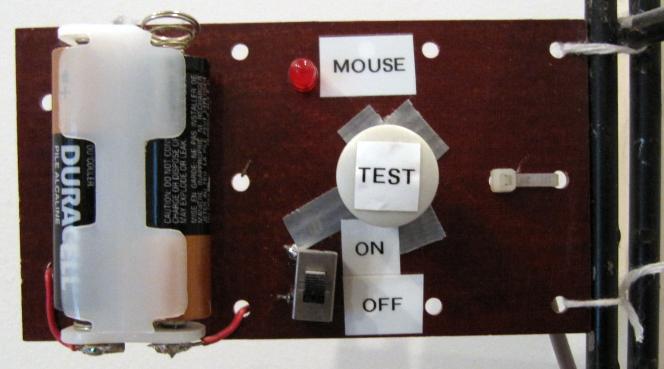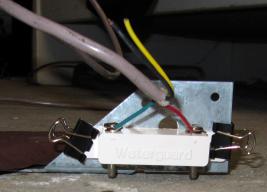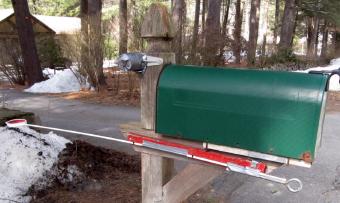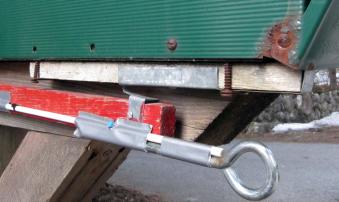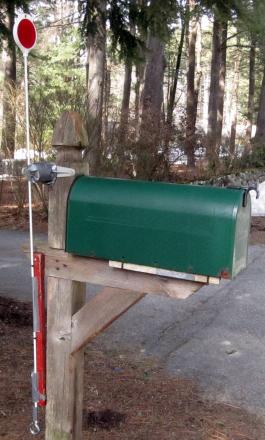 In an earlier blog entry, I described a couple of the Gadgets I've built: a cup-carrier and a pill-reminder light. I also mentioned a method I use to easily distinguish between my two different types of eyeglasses, whether they're sitting on a table, or sitting on my head.
The TEST button turns on the light, verifying that the system is ON, and that the batteries (seen on the left side) are functional. In the attic, on a wooden base, I mounted a snap-type mouse trap, like the one shown below to the left, and a microswitch, like the one shown to the right:  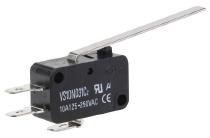 I chose a microswitch with a long lever actuator, like the one shown in the photo, and positioned it so that the rectangular snap arm of the trap, when set (as it's shown in the picture) depressed the lever. I wired the switch in a NORMALLY-CLOSED configuration, so that releasing the lever closed the circuit. Wires from the switch ran down through the wall to the mouse detector circuit board shown above. I mounted it near my bed, so I'd be sure to see it every night. Note 1 Moving from the attic in the top of the house to the basement at the bottom: Years ago, I woke up one morning, turned on a hot-water tap, and nothing came out. I raced down to the basement, and found it to be full of water to a depth of about 8 cm (about 3 inches). Our water heater had burst, and water had been pouring into the basement all night. Needless to say, many items stored in the basement were destroyed, and a major cleanup was required.
I used a commercial sensor that closes a circuit if a minute current is carried (by any conductive liquid) between the two prongs at the bottom, but I think this could be easily replaced at lower cost with a couple of inexpensive transistors. It seems clear that it would be best to have multiple water detectors in various places in the house - in the laundry room, in the crawl space under our master bath, and so on. Maybe I'll get to that some day. I'd like to have a variety of sensors around the house, actually, in addition to water sensors - things like intrusion detectors, freeze detectors, fire detectors, and so on. There are commercial systems available now that enable you to do this without extensive wiring - the various components communicate by radio. The systems connect to your internet router, and will send you text and/or e-mail messages in case of any problem. The final gadget I'll mention in this entry allows me to see, from my house, whether my mail has been delivered. I built it after I got tired of repeatedly walking out to my mailbox to check for mail, particularly since the hour of our mail delivery is highly irregular. The gadget is a sort of "flag" (made out of a driveway reflector) that pops up, and remains up, when the mailbox is opened. You can see it in its down position in the photo below (on the top-left). Beneath that picture, there's another showing the trigger mechanism in greater detail. The flag is shown in its raised position on the right (indicating the box was opened):
The lower-left picture showing the detail of the mechanism reveals how it works. In the picture, the door of the mailbox (just its bottom is seen in the upper-right corner of the photo) is just starting to open. You can see the bottom of the door starting to lower. As it continues in a circular arc, moving clockwise, it will push the light-colored piece of wood to the left. This pulls a metal tab out of a receiver (a metal ∩ shape) which supports the front end of the red-painted piece of wood (it's hinged at the back end). When the red-painted piece swings down, the flag swings up. The large galvanized steel eyebolt acts as a weight. A foam-rubber-and-duct-tape covered angle bracket stops the rod holding the reflector from swinging too far forward and possibly hitting the mailman. I specifically designed the mechanism so that the flag can be reset with one hand, since the other hand is needed to hold the mail that was in the box. It's possible to swing the red piece of wood up, and then, while supporting it with the left hand, use the same hand to slide the light-colored piece of wood to the right.
For quite a few years, the flag consisted only of the piece of red-painted wood. That's all that's needed in the Spring, Summer, and Fall. In those seasons, I can see from the house that the red stick has dropped down. But in the winter, in clearing snow from the driveway and from around the mailbox, snow gets piled high between the mailbox and the house, to the point that the low-hanging red stick can no longer be seen. I found myself chopping down piles of snow to be able to see it, and due to the position of the piles that had to be reduced in height, this was a rather awkward process. So I recently grafted the driveway reflector onto the back end of the red-painted stick, adding the galvanized steel eyebolt as a necessary counterweight to it. This raises the highly visible reflective circle well above any snow in the winter, and it's easier to see in the other seasons as well (remember, the mailbox is about 30 meters away, as noted above). I used to love building gadgets, and in fact I still do. I have lots of other helpful things I'd like to build, partly for their utility, and partly just for the fun of it. I thought that in retirement, I'd construct lots of these. But as of October, 2013, I've been retired for ten years, and I find I've gotten around to very few of them. When I first retired, I made rather a point of not having very much that I had to do - I could just relax, without guilt. Even today, ten years later, I can spend a morning doing nothing more than the daily crossword and the Sudoku and KenKen puzzles. In addition, the Internet is a massive time-sink. Once I start browsing news sites, and begin following links sent to me by my Facebook Friends, hours can easily go by. I've recently decided that I don't like this. I'm hoping to waste less time on these pursuits, and have more time for some of my projects. Although some might consider them an equal waste of effort, I think that I'd prefer spending my time that way. But we'll see - habits are hard to break. If I do manage to undertake some additional projects, the loyal readers of my blog will be the first to know.
  Note 1: Why bother with this? Why not just look at the trap every day? Well, because that actually wasn't so easy. The trap was in the attic, and checking it required swinging down the attic steps (normally retracted in the ceiling), and climbing up. I tended to forget to do this, resulting in decomposed, and sometimes partially eaten mice in the traps. It was better to remove a mouse while it was still fresh. A side benefit was that a mouse corpse known to be fresh could be passed on to Alison, our neighbor across the street, a licensed Wildlife Rehabilitator. At any given moment, Alison was apt to have in her flight cage a recovering raptor, which would be delighted to eat a freshly-killed mouse. But Alison couldn't take the risk of feeding her charges a mouse that might have been several days old. I used this method for years, but I've actually stopped using it. Although snap-traps usually result in a clean kill, every now and then the trap would get bloodied, and since it was screwed down to the wooden base, it wasn't that easy to replace. I've more recently been using traps only once, and discarding them, mouse and all. Some day, perhaps I'll build a mouse detector with a microphone that will detect a sprung trap by the sound of the loud snap (using the output of the mictophone to set an electronic latch that lights the indicator). [return to text]
 |
